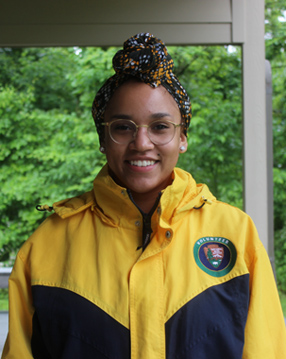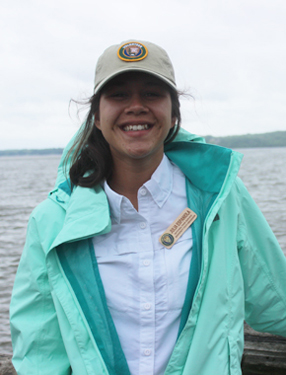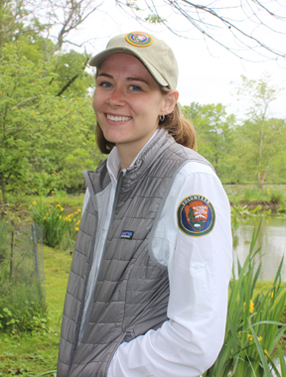The NPS Biodiversity Youth Ambassadors were asked to think about their time at BioBlitz 2016 in and around Washington, DC. On their first day out in Dyke Marsh Wildlife Preserve and Teddy Roosevelt Island, the ambassadors were reminded of the importance of service in NPS.
Lurleen

Today I noticed that Washington D.C. is similar to San Francisco in a lot of ways. The city park type vibes remind me of the Presido- a site within the Golden Gate National Parks. So far Washington D.C. has been amazing, there is a lot to see - from green landscapes to monuments. I love how everything is just a walk away and all the history that ties in with these parks.
Today we worked with the Easy-Macro lenses for the first time and I learned how to use them. You just strap the rubber band to your phone, match it to the lense and get really close to whatever species your looking at. We did a small little tutorial with them yesterday for the first time by exploring the area and practicing taking pictures of the plants and insects around the Teddy Roosevelt Island monument. I was a little hesitant about taking the pictures at first because the camera lense is blurry before you take the picture but once you get close to the insects or plants everything comes into full view. I was glad I did it.
Mikaila

Today I learned about invasive plants, and had the chance to remove the English ivy from some trees in Dyke Marsh Wildlife Preserve. A couple of trees required me to carefully use a saw to remove the vines from the tree, while others only required me to use clippers. Although we learned about many different native and invasive plants, I would also like to learn more about the flora and fauna of other habitats.
In the future, I would like to see more volunteers working to free trees of English ivy, poison ivy, etc. which will result in healthy, abundant trees and habitats.
Ben

It was an early morning for the ambassadors in our nation's capital.
We shuffled into a bus and headed off to Dyke Marsh to spend a day learning about invasive plant species. Upon arrival, it was clear that the woodlands around the marsh were over-run by an aggressive plant called English ivy. We could not see the trunk or branches of the trees because they were covered in ivy. It was killing the trees and without them, half of the animal species in the area would also die.
With a saw and clippers, we freed the trees from the suffocating vines, allowing them to grow healthier and helping to save the marsh's ecosystem.
Dara

Ever since the National Park Service (NPS) was created, it has been the goal to bring the public to the parks so they can connect with nature while preserving many ecosystems across the nation, and much of this has been accomplished.
Another thing I would like to see accomplished in the national parks in the next 100 years is for all invasive species to be eliminated. Members of the NPS are already working so hard to get rid of the invasive species, but the growth rate is outnumbering the extermination efforts.
It may seem unrealistic to hope for the disappearance of invasive species existence, but if it were to happen so many forms of biodiversity would be saved.
Caleb

My hope for the future is that there will be more people interested in the parks who have a strong sense to preserve the land that is left in the United States. I would like to see the continuation of conservation and protection for parks in the future.
I also hope that people will come to appreciate parks already present and bring funding to small parks that desperately need it.
Julia

As technology advances, I think a challenge for NPS, as well as many conservation/natural-preservation based agencies and organizations is reminding people of the roots of civilization and the significance of these lands, places, species, and histories. As our societies continue to develop, I think the priority of the majority of the population seems to shift more often than not. While the world surrounding our natural area and national parks is changing so rapidly, the challenge is updating/keeping our parks important to the minds of the community while still preserving and maintaining the spirit and resources of our parks. Basically, reminding people why parks are important!”
I will cherish the chance we got to go to Dyke Marsh Wildlife Preserve and remove the invasive English vines. I can say I saved (hopefully) two trees today and although I wasn’t familiar with these natives, it felt so good to make a small change (you have to start somewhere!). It was a beautiful area and I hope it can remain for future generations.”
Katherine

Today we had the chance to pull invasives from Dyke Marsh. English ivy was the most abundant species, covering the ground and creating thick barriers around the trees themselves. It was amazing to work alongside fellow youth ambassadors to remove the English ivy. At one point, there were two of uson one tree sawing and clipping the new and old growth, working to save a small tree.
Being new to the Biodiversity Youth Ambassador Program, I was amazed at the teamwork and unity I felt working alongside other people who share similar values. It was a beautiful reminder that environmental stewardship is important across the globe
Parker

Part of being a Youth Ambassador is having a sense of service to natural spaces. Every youth ambassador teamed up today to tackle a growing invasive species problem with the English ivy. Non-native species such as the English ivy harm trees in the forest by clinging on the bark and using parasitism to suck out water and nutrients. I’m glad that the other ambassadors were excited to help keystone species like the many species of canopy trees in the forest.
Service is always an important part of the preservation of the national parks.
Last updated: August 18, 2016
